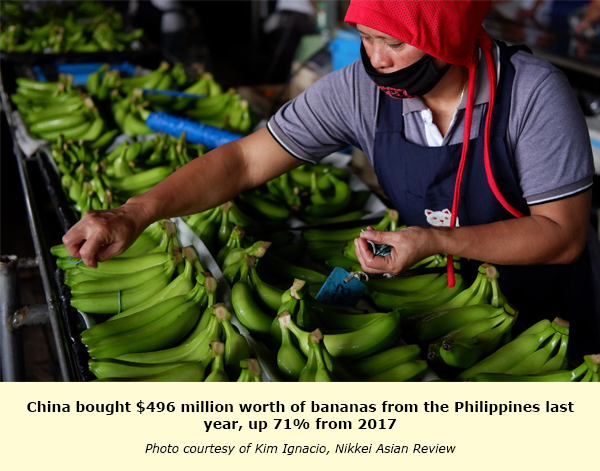At a 1,000-hectare plantation in the deep south of the Philippines, dozens of middle-aged workers sing along to oldies such as “Hotel California” as they prepare freshly picked bananas for export to China.
“In the afternoon, it’s like a disco,” said Naiall Biol, manager at the farm in Davao del Norte Province. “The loud music helps keep them alert, focused and agile.”

The workers need the motivation to handle rising demand from China, Biol told the Nikkei Asian Review.
China became the largest importer of Philippine bananas last year, dislodging Japan, which had been the biggest market for decades. Some companies are now eschewing Japan for full-year supply contracts with Chinese importers.
With Asia’s two biggest economies jockeying for influence in the Philippines, the shift symbolizes Manila’s growing dependence on China over Japan. While Tokyo pushes rail projects to get the upper hand in infrastructure, Beijing doubles down on agriculture.
“The Chinese are not only doing this because they hanker for Davao bananas,” said Herman Kraft, a professor of international relations at the University of the Philippines. “There is a political aspect to this.”
Chinese President Xi Jinping set the stage for banana diplomacy when Philippine President Rodrigo Duterte visited Beijing in October 2016 — a trip during which he announced his country’s “separation” from the U.S., its main ally. In return, Xi vowed to import more Philippine fruits and pledged investments worth USD24 billion.
Last year, China bought $496 million worth of bananas, up 71% from 2017, while orders from Japan rose 24% to $485 million, according to Philippine government data.
“In a way, bananas became a symbol of the relationship between the two countries,” Kraft said.
Diplomatic and economic relations have not always been sweet between Beijing and Manila, with a bitter territorial dispute having once hit banana growers hard. After an April 2012 standoff between Chinese and Philippine naval forces in the South China Sea near Scarborough Shoal, Beijing apparently retaliated by banning many Philippine banana imports.
China claimed the bananas were tainted with pests, however Stephen Antig, executive director of the Pilipino Banana Growers and Exporters Association, said the move was “purely political.”
“Even before, those insects were already there but they never rejected the bananas,” Antig recalled. “Only when we started claiming that Scarborough Shoal was ours [did] they suddenly become stricter.”
Industry officials said it was a difficult time that left farms littered with rotten bananas and shipments stranded in ports.
“A lot of companies at that time filed for bankruptcy. It was a crucial turning point for many,” said Han Da Bae, chairman of the Mindanao Banana Farmers and Exporters Association, a small group of smaller China-focused traders.
Manila filed for arbitration in 2013 to resolve the maritime incident, straining relations with Beijing. Just months before Duterte was elected in May 2016, Chinese authorities destroyed 35 tons of Philippine bananas worth $33,000 for failing to comply with sanitary requirements.
But Duterte’s pivot to China eased tensions. Chinese officials now pledge to increase imports of bananas and other fruit whenever meeting their Philippine counterparts. Xi did the same during a meeting with Duterte in April.
Meanwhile, Japan is clamping down on imports of Philippine bananas. Last year, inspectors found one box that contained excessive amounts of a pesticide, prompting random testing of all Philippine bananas this year that increases costs for exporters.
As Philippine officials struggle to persuade Japan to ease up, some companies have chosen to ditch the Japanese market.
ARR Agribusiness is shipping all its produce to China this year, said Raffy Caycong, who supervises the company’s 84-hectare plantation in Davao Del Norte. The company used to export 30% of its harvest to Japan, which slaps on tariffs of 8-18%. Exports to China, in contrast, are duty free.
“Japan is too strict, but China is not that strict,” Caycong said.
A decade ago, exporters would scramble to attract Japanese buyers looking for class A Philippine bananas — 30-40% pricier than class B, which are slightly bruised. But China’s growing middle class now wants premium fruit, making the country a more attractive market than Japan, whose shrinking population limits growth.
Philippine banana exports totaled nearly $1.4 billion last year, making the country the second-largest shipper after Ecuador. The sector employs around 400,000 people (including prisoners), many from the Davao region on the southern island of Mindanao, the president’s home turf. Some banana exporters even contributed to Duterte’s 2016 presidential campaign.
Kraft said the ties between bananas and Davao mean that increased purchases are a way for China to gain a diplomatic edge.
“This is fundamentally a Davao thing,” Kraft said. “For Duterte, politics is still local. It’s still what will benefit the people of Davao in the end.”
China has agreed to fund infrastructure projects in Mindanao worth billions, while Japan has targeted railway projects in Manila.
“Every time [Duterte] goes out of the country, he is like a salesman trying to sell Philippines bananas in Japan, Korea and China,” Antig said.
Bananas are at the top of the agenda in the Philippines’ ongoing trade talks with South Korea, and exporters are preparing to increase shipments to Russia. Even difficult markets like Australia are thinking about letting Philippine bananas in.
Yet cultivating new markets is not easy. While China is providing a boost to the sector, Antig still favors Japan, describing it as a “stable market.”
Smaller exporters who have benefited from the shifting dynamic are also seeing the downside of overreliance on the Chinese, some of whom have been negotiating directly with small growers, cutting out the middle men for a better deal, according to MBFEA’s Bae.
“In the meantime, we’ll take advantage of the good ties with China,” Bae said.
Antig added: “How can you go wrong with a market of 1.3 billion people?”
